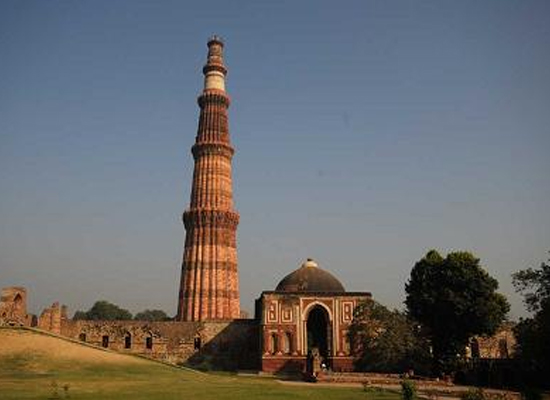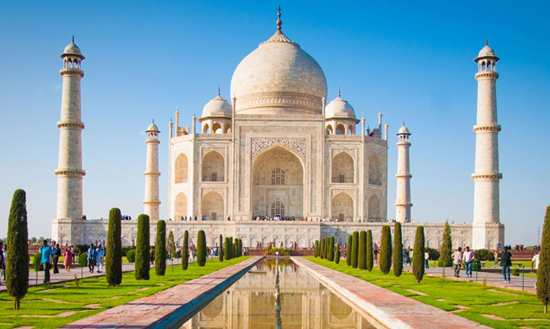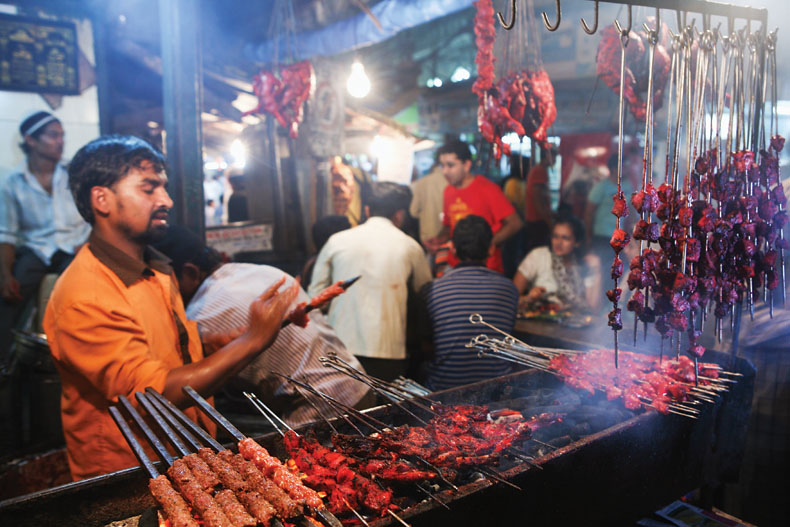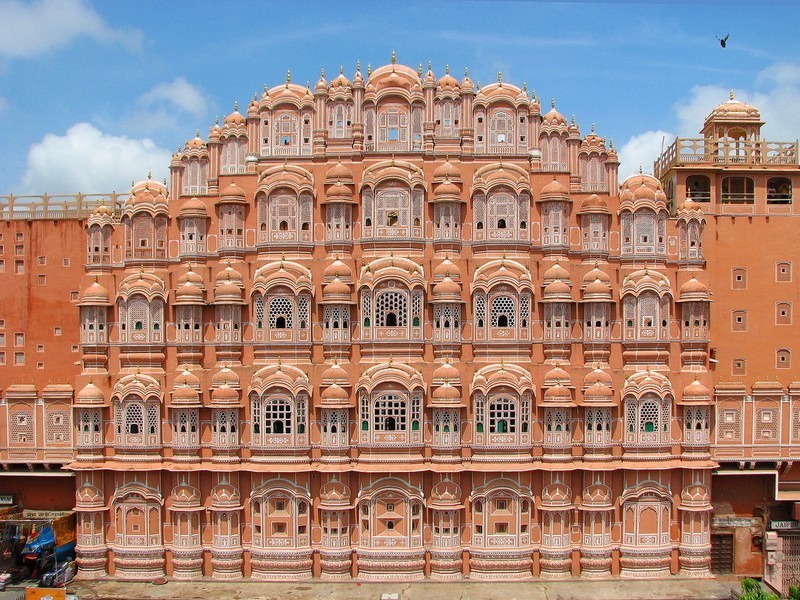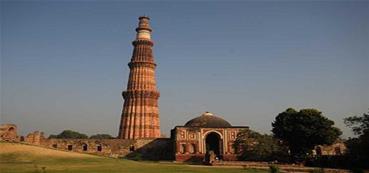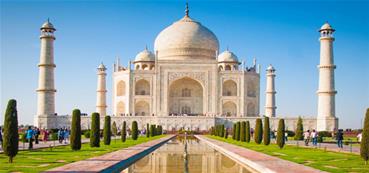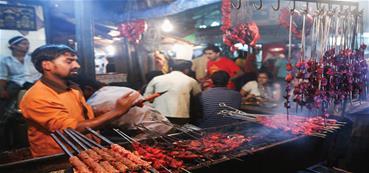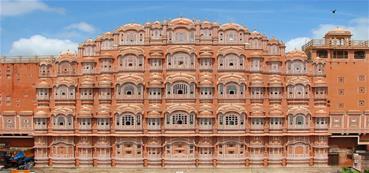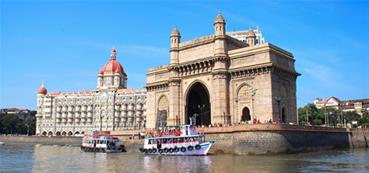Arrive by evening /night flight at Indira Gandhi International airport
Meet, Greet & Welcome at the airport by our office representative & transfer to hotel
DELHI: New Delhi, the capital and the third largest city of India is a fusion of the ancient and the modern. Standing along the West End of Gangetic Plain, the capital city, Delhi, unwinds a picture rich with culture, architecture and human diversity, deep in history, monuments, museums, galleries, gardens and exotic shows. Comprising of two contrasting yet harmonious parts, the Old Delhi and New Delhi, the city is a travel hub of Northern India.
Narrating the city's Mughal past, Old Delhi, takes you through the labyrinthine streets passing through formidable mosques, monuments and forts. You will also discover lively and colourful bazaars that boast to cater all sorts of good and items at mind-blowing prices amidst a barely controlled chaotic ambience. The imperial city of New Delhi displays the finely curved architecture of British Raj. It generates a mesmerizing charm reflecting well-composed and spacious streets under the shade of beautifully lined avenues of trees and tall and imposing government buildings.
On arrival, Check-In at hotel
Overnight at hotel
Breakfast at hotel
Morning start your visit of New Delhi with drive past the President’s House, the Rashtrapati Bhavan (from out-side) and the two flanking Secretariat buildings – the nerve center of Government activity. Driving down this hill is the India Gate, the great memorial arch built to commemorate the slain heroes of World War -1 and Indo-Afghan war. Around India Gate are palaces of some erstwhile princely states that our now public offices and museums.
Further visit of Delhi’s past Qutab Minar - is at 72.5 meters the world's tallest brick minaret. Construction commenced in 1193 under the orders of India's first Muslim ruler Qutab-ud-din Aibak, and the topmost storey of the minaret was completed in 1386 by Firuz Shah Tughluq. The Qutab Minar is notable for being one of the earliest and most prominent examples of Indo-Islamic architecture. It is surrounded by several other ancient and medieval structures and ruins, collectively known as Qutab complex. The complex is listed as a UNESCO World Heritage Site.
Further we will bring you at Saffron Palate to experience an authentic Indian Kitchen. It includes Market visit, cooking classes followed by Meal (Lunch)
Undoubtedly the best way to truly understand a country and its people is to visit them in their home, discuss their culture and history & have their Food!
Visit a local market to refresh the senses with the fragrance of fresh spices & vegetables. Follow up with a fun hands on cooking class & Meal.
An Authentic Culinary Experience starts from understanding basic ingredients needed for creating the perfect dish, applying simple nuances to it & finally indulging the tummy and heart with it. This itinerary combines a perfect culinary experience all in one. Its a simple three ‘course’ itinerary!
It starts off by understanding how the spices and vegetable are picked by visiting a local market. Get a feel of how an Indian would purchase the ingredients to make delicious Indian dishes.Understand the time tested yet simple nuances that need to be kept in mind when preparing Indian cuisine. Relish this experience by enjoying the Indian delicacies cooked by you with some help from us.
Afternoon Visit Spice and Dry Fruit Market along-with other highlights of Old Delhi.
Khari Baoli is a street in Delhi, India known for its wholesale grocery and Asia's largest wholesale spice market selling all kinds of spices, nuts, herbs and food products like rice and tea.Operating since the 17th century, the market is situated near the historic Delhi Red Fort, on the Khari Baoli Road adjacent to Fatehpuri Masjid at the western end of the Chandni Chowk.
Later we bring you try a famous Indian Dessert - Jalebi at Old famous Jalebi Wala.
Thick and juicy, it is food porn at its best. Jalebis, the golden-colored rings of deep-fried maida batter, soaked in sugar syrup, fill the mouth with a warm liquid of such excessive sweetness that modesty blushes in shame. The diabetic may find joy in just looking at its preparation.
Also enjoy a Cycle rickshaw ride through the busy bazaars of the Chandani Chowk area.
Followed by visit of Jama Masjid & Raj Ghat, the memorial site of the Mahatma Gandhi
Raj Ghat: is a memorial to Mahatma Gandhi. It is a black marble platform that marks the spot of Gandhi's cremation on 31 January, 1948. It is left open to the sky while an eternal flame burns perpetually at one end. It is located on the banks of the river Yamuna in Delhi in India. A stone footpath flanked by lawns leads to the walled enclosure that houses the memorial. Two museums dedicated to Gandhi are located nearby. The memorial has the epitaph Hē Ram, (literally 'O' Ram', but also translated to 'O God'), believed to be the last words uttered by Gandhi. The memorial was designed by Vanu G. Bhuta. It was originally designed to reflect the simplicity of Mahatma Gandhi's life. The design that won the Govt. of India invitational competition had the black marble slab surrounded by red earth as none of Gandhiji's ashram residences had any "English lawn". The memorial has gone through a number of design changes since then. A few at the behest of Jawaharlal Nehru, the first Prime Minister of independent India
In recent years, it has become customary for foreign dignitaries visiting India to pay their respects to Gandhi at the Raj Ghat by laying flowers or wreaths on the platform. As a sign of respect, visitors are required to remove footwear before approaching the memorial. A commemorative ceremony is held every Friday. Prayer sessions are held at the Raj Ghat on Gandhi's birth and death anniversaries.
Return to hotel and Overnight stay.
Breakfast at hotel
Check out from hotel & transfer to Railway station to board Satabdi train to Lucknow.
Depart Delhi 0645 Hrs.
Arrive Lucknow 1122 Hrs. (Scheduled timings; Subject to change)
Assistance on arrival at Lucknow Railway station and transfer to hotel
Lucknow: The hallmark of cultural extravaganza, known all over the world for its many splendours. A city that has a magical charm, a charm that’s forever and a charm that’s apart. Be it the cultural charm or the monumental one, all are well conserved here to make Lucknow ” The city of many splendours”. Walking through the lanes and by-lanes of Chowk and Aminabad one finds Lucknow of yore. The ‘tehzib’ or mannerism is still prominent and a topic of great appreciation. This is a city that still speaks the language of “aap-janab” and the dictum of “pehle aap” is still a part of everyday life for a true Lakhnawi. – and so natural it is – Aadab or salutation which has its own sophistication and style. Dress forms though have changed noticeably in the span of a century, yet the beauty and charisma of Chikan – the intricate and delicate hand embroidery, still rules the wardrobe. Lucknow is in fact among a few cities that duly understands the grace of the ‘dupattas’ or the covering cloth.
On arrival, check-In at hotel and rest of the afternoon at leisure.
Evening Culinary walk at City of Nawab’s to discovering Awadhi cuisines.
(Duration approx. 1.5 Hrs.)
Lucknow as a city has carved a niche by attracting gastronomes. Till date Lucknowites spend the most of their earnings and time on their kitchens. Lucknow is one place that has a full colony of chefs called, ‘Bawarchi Tola’ and then there is a full street, where one can find the best from Lucknow’s very own traditional kitchens.
We take you for this evening walk and make you hop-in, hop-out of the traditional roadside eateries, making you try the best that is on the menu. This is a guided tour with our own set of cutlery and basic dining essentials. It allows you to experience the best of the best, at the unpretentious eateries, without having to worry about how to eat without a fork or to wipe your hands clean after you are done.
IMP- This tour is essentially for meat eaters and takes you to the most authentic eateries that actually invented/mastered the dishes more than 100 years ago, is conducted every day except Thursdays and Sundays at 1845 hrs.This walk also remains suspended during festivals such as on 10th Mohorram and 6 days after Eid.
Return to hotel and Overnight stay
Breakfast at hotel
Full day city tour of Lucknow includes (Historical & Colonital sites)- Bada & Chhota Imambara, Jama maszid, Saadat Ali Khan Tomb, Vidhan Sabha Bhawan, British Residency.
Asafi Imambara (Bara Imambara): Also known as the Bara Imambara, it was built by Nawab Asaf-ud-Daula in 1784 and is one of the architectural wonders of that era. Its central hall is said to be the largest vaulted chamber in the world. Except for the galleries in the interior, there is no woodwork in the entire structure. It has large underground passages which have been blocked up. A staircase from outside leads to a series of labyrinths known as Bhool-Bhulaiyan which is a complicated entanglement of zig-zag pass. Visitors are advised to visit only with authorized guides. Within the compound of the Imambara is the grand Asafi Mosque. Shahi Baoli is another attraction here.
Chhota Imambara: Though Popularly called as the Chhota Imambara, the Hussainabad Imambara stands to the west of Bara Imambara. Built by Nawab Mohammad Ali Shah (1837-42), it is more ornate in design with exquisite chandeliers, gilt-edged mirrors, silver mimbar and colourful stuccos which adorn the interiors. A golden dome and fine calligraphy on the exterior of the building makes it a truly exceptional monument of Mughal architecture
Vidhan Sabha Bhawan (The Council House): Its foundation was laid in 1922 by Sir Harcourt Butler and the construction was completed in six years. Its octagonal shaped chamber has a domed roof decorated with peacocks in fully plumed splendor. (From Outside only – No photography is allowed)
Later visit of British Residency - The British Residency of Lucknow is a famous historical landmark of this place. It is now in ruins and has been declared a protected monument by the Archaeological Survey of India. The British Residency was the place that served as a refuge for approximately 3000 British inhabitants during the time of the uprising of 1857.
Lucknow was centre of all British activities during the siege and the Residency became the monopolistic centre of the British for almost 90 days. The Residency still has within its walls, the graves of around 2000 British soldiers who died in the Revolt of 1857. The people of Lucknow tell intriguing stories of British who fled from their homes to seek shelter in these red buildings. Only a 1000 inhabitant survived this tough ordeal. On November 17th, the British troops led by Sir Colin Campbell defeated the Indian forces. Though they triumphed, it was victory in the true sense.
Return to Hotel & Overnight stay
Breakfast at hotel
Check-out and drive by surface to Agra
Agra: became the capital of Sikandar Lodi in 1501, but was soon passed on to the Mughals, both Babur and Humayun made some early Mughal constructions here. It was under Akbar that Agra first aspired to its heights of magnificence from 1570-85 he ruled from nearby Fathepur Sikri , when he abandoned that city he moved to Lahore ( now in Pakistan ) but returned to Agra in 1599 , all later Mughal rulers ruled from Agra till 1761 it fell to the Jats who did much damage to the city.
On arrival, check-in at hotel
Rest of the day free for personal activities
Overnight at hotel
Breakfast at hotel
Morning proceed to visit the Symbol of Love “Taj Mahal”
Start tour with visit the Taj Mahal (1631-1653), a poem in white marble, built by Shah Jahan in memory of his beloved wife, Mumtaj Mahal. Rabindranath Tagore calls "a teardrop on the cheek of time". Taj Mahal means "Crown Palace" and is in fact the most well-preserved and architecturally beautiful tomb in the world. It is best described by the English poet, Sir Edwin Arnold, as "Not a piece of architecture, as other buildings are, but the proud passions of an emperor’s love wrought in living stones."
Followed by visit of Glorious Agra Fort- built alongside the Yamuna River stretching almost 2.5 km. The fort’s colossal double walls rise 20 m in height and measure 2.5 km in circumference. The fort is surrounded by a moat.
Late afternoon, we will take you to culinary walk.
Savour local flavours as you taste paradise on a fun filled journey of discovery. Indian food makes a large part of brand India, with delicacies such as Chicken Tikka Masala being named as the national dish of the U.K. If you have a picture of a colourful city with bustling streets, true to its gastronomic style, Agra is one place that you, the hungry traveller will never be disappointed with. It is famous for its Petha and the different varieties of chaat.
Our food trail is a journey, not just of taste, but of knowledge, as passionate people tell you about how this food has ended up on your plate. This tour is approximately 2 to 3 hours foodie exploration of the City of Agra meant for those who think from the Stomach.
In the tour, we take you to the oldest and most popular food joints for tasting of a variety of Indian cuisine and chaat and show you a wholly different site of Agra, which you may not see being on any of the other tour.
Return to hotel and Overnight stay
Breakfast at hotel
Check Out & transfer to Jaipur En-route visiting fatehpursikri
Fatehpur Sikri the deserted red sandstone city that was built by Emperor Akbar as his capital. It was a veritable fairy tale city and its ‘ruins are still in a pristine condition. It is not hard to imagine what the court life must have been like in the days of its grandeur.
Continue trip to Jaipur
Jaipur: The capital city of the state of Rajasthan is popularly known as the “Pink City” because of the pink paint applies to the buildings in the old walled city. (In Rajput culture, pink was traditionally a colour associated with hospitality) The city owes its name, its foundation and its careful planning to the great warrior, astronomer Maharaja Jai Singh II (1699-1744). In 1727, with Mughal power on the wane, Jai Singh decided the time was ripe to move down from his somewhat cramped hillside fortress at nearby Amber to the new site. He laid out the city, with its surrounding walls and six rectangular blocks, according to principals of town planning set down in the Shilpa-Shastra, an ancient Hindu treatise on architecture
On arrival, Check-In at hotel.
Late afternoon city tour of Jaipur includes:
City Palace museum – an imposing blend of traditional Rajasthani and Mughal Art. The museum is resplendent with its collection of robes of Royal Princes, carpets, an armory of old weapons, miniature paintings portraying court scenes, battle scenes and processions. Also visit Jantar Mantar (observatory) – which is the largest stone and marble crafted observatory in the world. Situated near the gate of the City Palace, the observatory has 17 curiously shaped instruments, many of them still in working condition
Later - experience a ride on the traditional Cycle Rickshaw. Enjoy a ride through the bustling city area of Jaipur.
Return to hotel and Overnight stay
Breakfast at hotel
Morning visit Fort Amber by Elephant/Jeep (Subject to availability)
Amber Fort 11 kms from Jaipur – marvellous example of Rajput architecture with its terraces and ramparts reflected in the Maota Lake below. The fort interior has various royal halls decorated with intricate ivory work, exquisite wall paintings and tiny mirror chips, which create a tantalizing reflection effect. En-route to Fort; Photo stop at Hawa Mahal
Return to hotel and rest of the day at leisure
Late afternoon experience the culinary tour (Rajasthani Traditional cuisine) of Pink City - Jaipur
Jaipur, the capital of Indian state of Rajasthan, has lots to offer not only in terms of sightseeing but also Rajasthani traditional food. During this food tour in Jaipur you will visit those restaurants or local cuisine shops which even amongst those people who have been living here for many years remain a secret. This tour can be as an attempt to promote Indian food and culture to tourists looking for a way to have the real India experience.
This tour is a 2-3 hour long which will begin sharp at 4pm in the evening. The walking and rickshaw tour consists of sampling 5 to 6 different Indian food dishes from up to 8 different food vendors spread all over city. During the food tour you will walk through beautiful narrow lanes to visit the famous vendors where local heights wait in long queue for their number to have the specialties of Rajasthan. At the established food places which are spread all across city, you will taste some authentic dishes like Jaipur ki dal kachori, Tikiya cholae, Jaipuri kulfi, Lassi, Rabdi, etc.
Later we take you to an Indian Home where a Cooking Demonstration followed by Dinner, will be organized especially for you by the housewife. She will show how to prepare some famous Indian dishes
Return to hotel and Overnight stay.
Breakfast at hotel
Check Out from hotel and drive to Jodhpur
En-route vising the Pushkar
Pushkar - Separated from it by Nag Pahar (Snake Mountain), and situated right on the edge of the desert, is this town clinging to the side of a small but beautiful Pushkar Lake, with its many bathing ghats and temples. It’s world famous for camel and cattle fair. At this time the town is thronged with tribal people from all over Rajasthan & Pilgrims from all over India. There are many temples, though few are as ancient as you might expect at such a pilgrimage site, since many were destroyed by Aurangzeb and subsequently rebuilt. The most famous is the only temple in India dedicated to Brahma. It’s marked by a red spire and over the entrance gateway is the Hans (goose symbol of Brahma).
Continue drive to Jodhpur
Jodhpur: At the edge of the Thar Desert, stands the 2nd largest city of Rajasthan – Jodhpur. The city is totally dominated by the massive fort, topping a sheer hill which rises right in the middle of the town. Founded in 1459 by Rao Jodha, a chief of the Rajput clan known as the Rathores. The Rathore kingdom was once known as Marwar, the Land of Death. It’s fascinating to wander around the jumble of winding streets in the old city. Eight gates lead out from the walled city. It’s one of India’s most interesting cities and, yes, it was from here that those baggy-tights horse-riding trousers, Jodhpuries took their name.
Upon arrival, Check-in at hotel and rest of the evening at leisure
Overnight at hotel
Breakfast at hotel
Morning proceed for city tour of Jodhpur
Mehrangarh Fort– founded in 1459 ad by Rao Jodha (after whom the city is named) the fort is intricately adorned with long carved panels and latticed windows of exquisite designs in Red Sandstone.
Also visit Jaswant Thada – an imposing white marble cenotaph built to commemorate the acts of bravery and generosity of the rulers in 19th century.
Late afternoon, will arrange a Cooking demo for you at Karni Bhawan Hotel. The Princely states of Rajasthan had their own culinary traditions and recipes. At Karni Bhawan, a boutique hotel run by the Royal Family of Sodawas, enjoy a cooking demonstration of the fine cuisine of Sodawas. besides learning and savouring the delicacies also enjoy the tradition and culture of the erstwhile Princes and Princesses
Return to your hotel and overnight stay.
Breakfast at hotel
Check-out and transfer to Airport to board Mumbai flight
Mumbai or Bombay, on the edge of the Arabian Sea is India’s commercial capital. It is a vibrant, confident metropolis that’s tangibly high in energy. Originally home to Koli fisher folk, seven swampy islands were combined by land reclamations to form today’s Mumbai. The largest of the island was part of a dowry given by Portugal to England. The British took control of the balance six islands and Bombay or the (“good bay” in Portuguese) was leased to the east India Company for a paltry 10 Pounds. The city that grew out of the cluster of islands was destined to become the face of emerging India in 19th & 20th centuries. Like New York, everybody was invited to pursue a “Bombay dream”.
Bombay is composed of immigrants from all parts on India and the world who came with the inspiration to fulfill their Bombay dream. These people and the institutions that they created, have made Bombay’s claim as “the city of dreams” stronger. Mumbai continues to play a very vital political, cultural and financial role in India after independence.
Assistance on arrival at Mumbai Airport and transfer to hotel
Rest of the day at leisure
Overnight stay.
Breakfast at hotel
Morning Excursion to Elephanta caves - a must for any visitor to India. Mute testimony of the golden age in Indian history during the gupta period and built to honor lord Shiva. Elephanta is a 3 Kms. Long elongated island, consisting of two hills separated by a valley. The caves with rock-cut figures and carvings are believed to be carved by the sculptors of Ajanta or Udayagiri.
(IMP - Elephanta Caves are closed on every Monday)
Afternoon city tour of Mumbai – The tour includes the 26 mtr high British-built Arch “Gateway of India”, Mumbai’s landmark built to honour the visit of George V and Queen Mary in 1911. Marine Drive dubbed as the Queen’s Necklace is Mumbai’s most popular promenades and a favorite sunset watching spot. The Kamla Nehru Park from where you have a picturesque view of the city, Hanging Gardens are so named since they are located on top of a series of tanks that supply water to Mumbai. Pass by the `towers of silence’ the crematorium of the Parsis. Also visit Mani Bhawan a private house where Mahatma Gandhi used to stay when he visited Mumbai. It is now a museum and research library
During the visit, we will bring you at Iranian Local Restaurant to experience the the Iranian authentic food
Return to hotel by evening
In time, check-out from hotel and transfer to Mumbai Intl airport
(Room will be provide till departure)
Board your return flight for home destination


